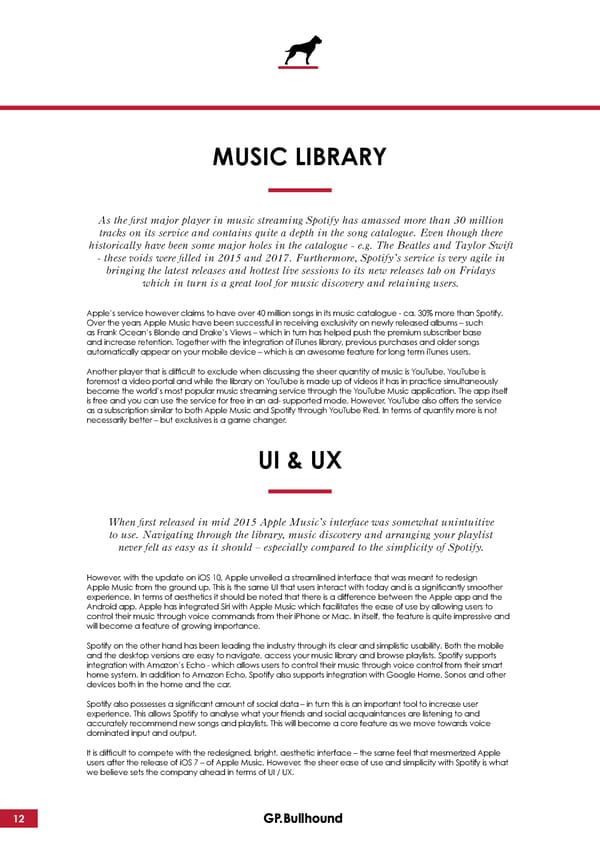MUSIC LIBRARY As the first major player in music streaming Spotify has amassed more than 30 million tracks on its service and contains quite a depth in the song catalogue. Even though there historically have been some major holes in the catalogue - e.g. The Beatles and Taylor Swift - these voids were filled in 2015 and 2017. Furthermore, Spotify’s service is very agile in bringing the latest releases and hottest live sessions to its new releases tab on Fridays which in turn is a great tool for music discovery and retaining users. Apple’s service however claims to have over 40 million songs in its music catalogue - ca. 30% more than Spotify. Over the years Apple Music have been successful in receiving exclusivity on newly released albums – such as Frank Ocean’s Blonde and Drake’s Views – which in turn has helped push the premium subscriber base and increase retention. Together with the integration of iTunes library, previous purchases and older songs automatically appear on your mobile device – which is an awesome feature for long term iTunes users. Another player that is difficult to exclude when discussing the sheer quantity of music is YouTube. YouTube is foremost a video portal and while the library on YouTube is made up of videos it has in practice simultaneously become the world’s most popular music streaming service through the YouTube Music application. The app itself is free and you can use the service for free in an ad- supported mode. However, YouTube also offers the service as a subscription similar to both Apple Music and Spotify through YouTube Red. In terms of quantity more is not necessarily better – but exclusives is a game changer. UI & UX When first released in mid 2015 Apple Music’s interface was somewhat unintuitive to use. Navigating through the library, music discovery and arranging your playlist never felt as easy as it should – especially compared to the simplicity of Spotify. However, with the update on iOS 10, Apple unveiled a streamlined interface that was meant to redesign Apple Music from the ground up. This is the same UI that users interact with today and is a significantly smoother experience. In terms of aesthetics it should be noted that there is a difference between the Apple app and the Android app. Apple has integrated Siri with Apple Music which facilitates the ease of use by allowing users to control their music through voice commands from their iPhone or Mac. In itself, the feature is quite impressive and will become a feature of growing importance. Spotify on the other hand has been leading the industry through its clear and simplistic usability. Both the mobile and the desktop versions are easy to navigate, access your music library and browse playlists. Spotify supports integration with Amazon’s Echo - which allows users to control their music through voice control from their smart home system. In addition to Amazon Echo, Spotify also supports integration with Google Home, Sonos and other devices both in the home and the car. Spotify also possesses a significant amount of social data – in turn this is an important tool to increase user experience. This allows Spotify to analyse what your friends and social acquaintances are listening to and accurately recommend new songs and playlists. This will become a core feature as we move towards voice dominated input and output. It is difficult to compete with the redesigned, bright, aesthetic interface – the same feel that mesmerized Apple users after the release of iOS 7 – of Apple Music. However, the sheer ease of use and simplicity with Spotify is what we believe sets the company ahead in terms of UI / UX. 12
 GP Bullhound Spotify Update October 2017 Page 11 Page 13
GP Bullhound Spotify Update October 2017 Page 11 Page 13